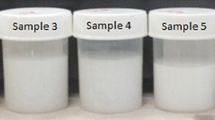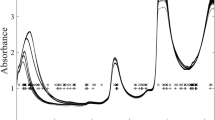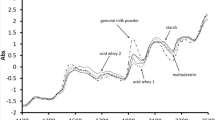Abstract
A surface enhanced Raman scattering (SERS) method is described for the determination of vanillin, methyl vanillin and ethyl vanillin at trace levels. Flower-like silver nanoparticles on a silicon wafer are used as the SERS substrate, and the analytes can be specifically and non-destructively recognized by their specific Raman bands. The molecules can be recognized rapidly by identifying the characteristic bands. The SERS spectra of vanillin (C8H8O3) were used as mid-contrast, and specific bands of methyl vanillin and ethyl vanillin (C9H10O3) were acquired at 775 cm−1, 1350 cm−1 and 1282 cm−1, 1382 cm−1, respectively. In addition, by using an improved principal component analysis (PCA) algorithm, the organic molecule can be quantitatively determined. Dissolved in water, vanillin, methyl vanillin and ethyl vanillin still can be detected at a concentration of 10−8 M, at which their characteristic Raman peaks are still visible. The method was successfully applied to the determination of vanillin in milk powder products.

Vanillin can be identified at trace levels by laser irradiation of milk and by using flower-like silver nanoparticles as the surface enhanced Raman scattering (SERS) substrate. Vanillin and its methyl and ethyl derivatives can be quantitatively analyzed by the principal component analysis (PCA) algorithm.






Similar content being viewed by others
References
Hocking M B (1997) Vanillin: synthetic flavoring from spent sulfite liquor. Journal of chemical education 74(9):págs. 1055-1059
Walton NJ, Mayer MJ, Narbad A (2003) Vanillin. Phytochemistry 63(5):505–515
Cláudio AFM, Freire MG, Freire CSR, Silvestre AJD, Coutinho JAP (2010) Extraction of vanillin using ionic-liquid-based aqueous two-phase systems. Sep Purif Technol 75(1):39–47
Di Gioia D, Luziatelli F, Negroni A, Ficca AG, Fava F, Ruzzi M (2011) Metabolic engineering of Pseudomonas fluorescens for the production of vanillin from ferulic acid. J Biotechnol 156(4):309–316
Torres BR, Aliakbarian B, Torre P, Perego P, Domínguez JM, Zilli M, Converti A (2009) Vanillin bioproduction from alkaline hydrolyzate of corn cob by Escherichia coli JM109/pBB1. Enzym Microb Technol 44(3):154–158
Roberts DD, Acree TE (1996) Effects of heating and cream addition on fresh raspberry aroma using a retronasal aroma simulator and gas chromatography olfactometry. Jagric food Chem 44(12):3919–3925
Havkin-Frenkel D, Belanger FC (2008) Biotechnological production of vanillin. In: Blackwell publishing ltd.
van Assendelft AH (1987) Adverse drug reactions checklist. Br Med J (Clinical research ed.) 294(6571):576–577
Saint DM, Coughtrie MW, Guilland JC, Verges B, Lemesle M, Giroud M (1996) Migraine induced by vanillin. Presse Med 25(40):2043
Hingse SS, Digole SB, Annapure US (2014) Method development for simultaneous detection of ferulic acid and vanillin using high-performance thin layer chromatography. J Anal Sci Technol 5(1):1–9
Jager LSD, Perfetti GA, Diachenko GW (2008) Comparison of headspace-SPME-GC–MS and LC–MS for the detection and quantification of coumarin, vanillin, and ethyl vanillin in vanilla extract products. Food Chem 107(4):1701–1709
Shu M, Man Y, Ma H, Luan F, Liu H, Gao Y (2016) Determination of vanillin in Milk powder by capillary electrophoresis combined with dispersive liquid-liquid microextraction. Food Anal Methods 9(6):1706–1712
Ai Y-j, Liang P, Y-x W, Q-m D, Li J-b, Bai Y, Xu B-J, Yu Z, Ni D (2018) Rapid qualitative and quantitative determination of food colorants by both Raman spectra and surface-enhanced Raman scattering (SERS). Food Chem 241:427–433
Y-x W, Liang P, Q-M D, Bai Y, Yu Z, Huang J, Zhong Y, Dai Y-C, Ni D, H-b S, Pittman CU Jr (2017) Design of a silver nanoparticle for sensitive surface enhanced Raman spectroscopy detection of carmine dye. Food Chem 237:974–980
Guo L, Jackman JA, Yang H-H, Chen P, Cho N-J, Kim D-H (2015) Strategies for enhancing the sensitivity of plasmonic nanosensors. Nano Today 10(2):213–239
Ryo Tsunashima, Shinichiro Noro, ‡, Tomoyuki Akutagawa, ‡, §, Takayoshi Nakamura, †, ‡, §, Tomohiro Karasawa, Hiroko Kawakami A, Toma‖ K (2007) One-Dimensional Array of Au Nanoparticles Fixed on Nanofibers of Organogelators by the Langmuir−Blodgett Method J Phys Chem C 111(2):901–907
Serge Ravaine, † G E F, † C T S, And J H A, ‡, † D R T (2002) Photochemical generation of gold nanoparticles in Langmuir−Blodgett films. Langmuir 14(3):708–713
Raguin L, Hafner C (2010) Plasmon resonances of gold nanostars. Proc SPIE 7712(5):77–89
Sun Y, Brian Mayers A, Xia Y (2003) Transformation of silver Nanospheres into Nanobelts and triangular Nanoplates through a thermal process. Nano Lett 3(5):675–679
Sun Y, Xia Y (2003) Triangular Nanoplates of silver: synthesis, characterization, and use as sacrificial templates for generating triangular Nanorings of gold. Adv Mater 15(9):695–699
Xiong Y, Washio I, Chen J, Sadilek M, Xia Y (2007) Trimeric clusters of silver in aqueous AgNO3 solutions and their role as nuclei in forming triangular nanoplates of silver. Angew Chem 46(26):4917–4921
Zheng H, Ni D, Yu Z, Liang P (2017) Preparation of SERS-active substrates based on graphene oxide/silver nanocomposites for rapid zdetection of l-Theanine. Food Chem 217:511–516
Zheng H, Ni D, Yu Z, Liang P, Chen H (2016) Fabrication of flower-like silver nanostructures for rapid detection of caffeine using surface enhanced Raman spectroscopy. Sensors Actuators B Chem 231:423–430
Chen S, Thota S, Reggiano G, Zhao J (2015) Generalized seeded growth of ag-based metal chalcogenide nanorods via controlled chalcogenization of the seeds. J Mater Chem C 3(45):11842–11849
Rajesh D, Sunandana CS (2012) Briefly brominated ag thin films: XRD, FESEM, and optical studies of surface modification. Appl Surf Sci 259:276–282
Mehta BK, Chhajlani M, Shrivastava BD (2015) Green synthesis of silver nanoparticles and their characterization by XRD. Green Chem 17(5):2825–2839
Panigrahi S, Praharaj S, Soumen Basu †SKG, Jana S, Pande S, Vodinh T, Hongjin Jiang A, Pal T (2006) Self-assembly of silver nanoparticles: synthesis, stabilization, optical properties, and application in surface-enhanced Raman scattering. J Phys Chem B 110(27):13436–13444
Zhang D, Liang P, Yu Z, Huang J, Ni D, Shu H, Q-m D (2017) The effect of solvent environment toward optimization of SERS sensors for pesticides detection from chemical enhancement aspects. Sensors and Actuators B: Chemical
Huang J, Liang P, Xu J, Wu Y, Shen W, Xu B, Zhang D, Xia J, Zhuang S (2017) Qualitative and quantitative determination of coumarin using surface-enhanced Raman spectroscopy coupled with intelligent multivariate analysis. RSC Adv 7(77):49097–49101
Acknowledgments
The Project was supported by the National Science Foundation for Young Scholars of China (Grant No.31000316). The Project was supported by the Application Research Program of Commonweal Technology of Zhejiang Province (No. 2014C37042). The Project was supported by the Zhejiang province university students in scientific and technological innovation activities (No. 2016R409011), and the Science and technology project of Zhejiang Province (No. 2016C33026).
Author information
Authors and Affiliations
Corresponding author
Ethics declarations
The author(s) declare that they have no competing interests.
Additional information
Publisher’s note
Springer Nature remains neutral with regard to jurisdictional claims in published maps and institutional affiliations.
Rights and permissions
About this article
Cite this article
Liang, P., Zhou, Y., Zhang, D. et al. SERS based determination of vanillin and its methyl and ethyl derivatives using flower-like silver nanoparticles on a silicon wafer. Microchim Acta 186, 302 (2019). https://doi.org/10.1007/s00604-019-3424-7
Received:
Accepted:
Published:
DOI: https://doi.org/10.1007/s00604-019-3424-7




